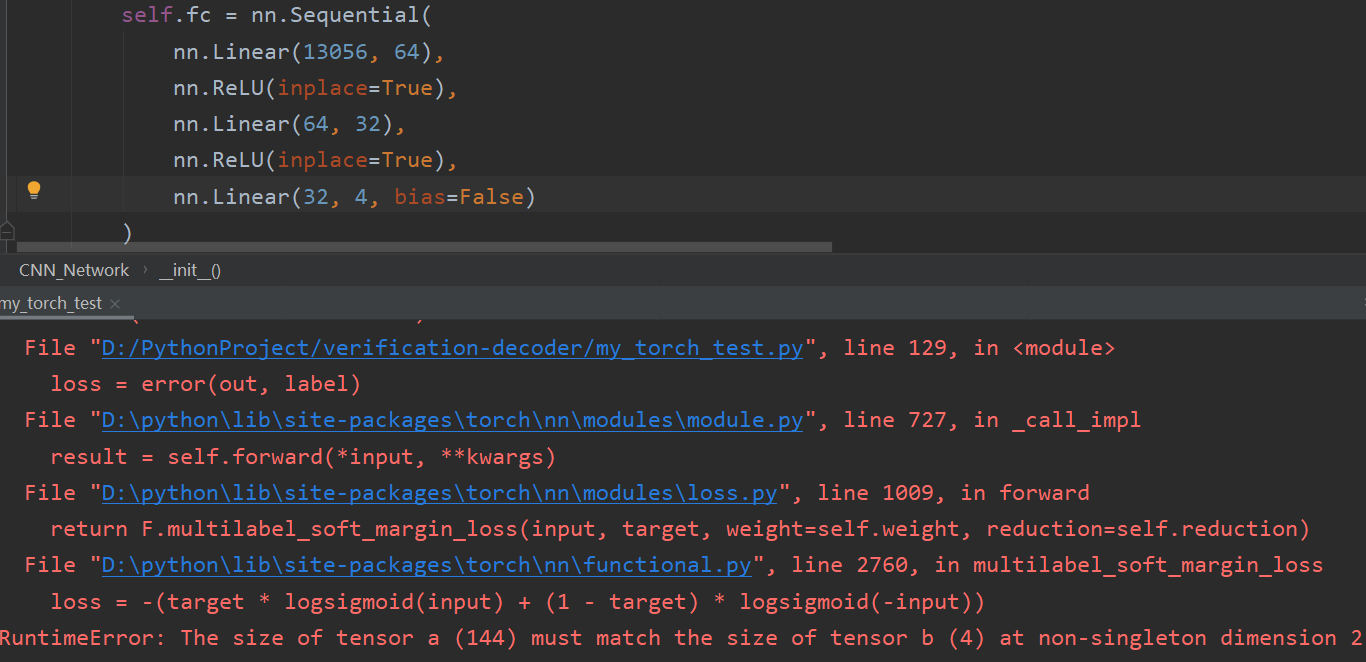who can help me?
import numpy as np
from PIL import Image
import glob
import torch
import torch.nn as nn
import torch.optim
from torch.autograd import Variable
from torch.utils.data import DataLoader, Dataset
import torch.nn.functional as F
from torchvision import transforms as T
def read_data():
"""
read img_file data
:return: img_path, img_name
"""
train_data = glob.glob('../train-images/*.jpeg')
train_label = np.array(
[train_data[index].split('/')[-1].split('.')[0].split('_')[0] for index in
range(len(train_data))])
return train_data, train_label
out_place = (
"0", "1", "2", "3", "4", "5", "6", "7", "8", "9", 'a', 'b', 'c', 'd', 'e', 'f', 'g', 'h', 'i', 'j', 'k', 'l', 'm', 'n', 'o', 'p', 'q',
'r', 's', 't', 'u', 'v', 'w', 'x', 'y', 'z', 'A', 'B', 'C', 'D', 'E', 'F', 'G', 'H', 'I', 'J', 'K', 'L', 'M', 'N', 'O', 'P', 'Q', 'R', 'S', 'T', 'U', 'V', 'W', 'X', 'Y', 'Z')
transform = T.Compose([
# T.Resize((128,128)),
T.ToTensor(),
T.Normalize(std=[0.5, 0.5, 0.5], mean=[0.5, 0.5, 0.5])
])
def one_hot(word: str) -> np.array:
tmp = []
# for i in range(len(word)):
for i in range(4):
item_tmp = [0 for x in range(144)] # [0 for x in range(len(word) * len(out_place))]
word_idx = out_place.index(word[i].lower())
item_tmp[i*36+word_idx] = 1
tmp.append(item_tmp)
return np.array(tmp)
class DataSet(Dataset):
def __init__(self):
self.img_path, self.label = read_data()
def __getitem__(self, index):
img_path = self.img_path[index]
img = Image.open(img_path).convert("RGB")
img = transform(img)
label = torch.from_numpy(one_hot(self.label[index])).float()
return img, label
def __len__(self):
return len(self.img_path)
data = DataSet()
data_loader = DataLoader(data, shuffle=True, batch_size=64, drop_last=True)
class CNN_Network(nn.Module):
def __init__(self):
super(CNN_Network, self).__init__()
self.layer1 = nn.Sequential(
nn.Conv2d(3, 16, stride=1, kernel_size=3, padding=1),
nn.BatchNorm2d(16),
nn.ReLU(inplace=True)
)
self.layer2 = nn.Sequential(
nn.Conv2d(16, 32, stride=1, kernel_size=3, padding=1),
nn.BatchNorm2d(32),
nn.ReLU(inplace=True),
nn.MaxPool2d(stride=2, kernel_size=2), # 30 80
)
self.layer3 = nn.Sequential(
nn.Conv2d(32, 64, stride=1, kernel_size=3, padding=1),
nn.BatchNorm2d(64),
nn.ReLU(inplace=True),
nn.Conv2d(64, 128, kernel_size=3, stride=1, padding=1),
nn.BatchNorm2d(128),
nn.ReLU(inplace=True),
nn.MaxPool2d(kernel_size=2, stride=2), # 15 40
)
self.fc = nn.Sequential(
nn.Linear(256 * 15 * 40, 2048),
nn.ReLU(inplace=True),
nn.Linear(2048, 1024),
nn.ReLU(inplace=True),
nn.Linear(1024, 40)
)
def forward(self, x):
x = self.layer1(x)
x = self.layer2(x)
x = self.layer3(x)
x = x.view(x.size(0), -1)
x = self.fc(x)
x = F.softmax(x, dim=-1)
return x
model = CNN_Network()
model.train()
optimizer = torch.optim.Adam(model.parameters(), lr=0.002)
error = nn.MultiLabelSoftMarginLoss()
for i in range(5):
for (batch_x, batch_y) in data_loader:
optimizer.zero_grad()
image = Variable(batch_x)
label = Variable(batch_y)
out = model(image)
loss = error(out, label)
print(loss)
loss.backward()
optimizer.step()
torch.save(model.state_dict(), "model.pth")
my image size [70, 26] and one of images name is okzi.jpeg
I am first touch pytorch so i don`t understand this question
Summary
This text will be hidden


